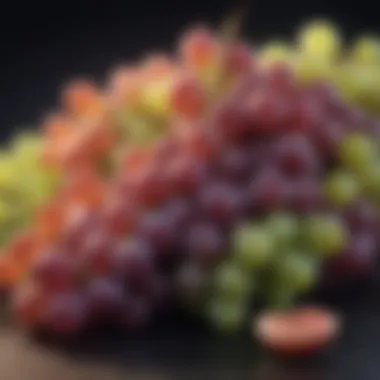Grapes and Cancer: Exploring Anti-Cancer Properties


Intro
Grapes have long stood as a symbol of health, appearing in various cultures and cuisines. Their association with wellness often sparks curiosity regarding their potential role in disease prevention, particularly in cancer. The complexity of cancer as a health issue necessitates a thorough examination of various factors contributing to its development and management.
This exploration of grapes and their possible cancer-fighting properties focuses on the diverse compounds they contain, such as polyphenols and antioxidants. Understanding these compounds and their mechanisms in relation to cancer biology is crucial. As we navigate through this investigation, it’s pertinent to address the significant role diet may play in cancer risk and prevention. Additionally, bioavailability of grape compounds and practical ways to incorporate them into one’s diet will be examined, providing insights that can be relevant to individuals looking to enhance their health.
The aim of this article is not merely to highlight the anti-cancer properties attributed to grapes but to provide a nuanced overview that encapsulates current scientific understanding. Armed with this knowledge, readers – including students, researchers, and health professionals – can better grasp how dietary choices may contribute to cancer prevention strategies.
Methodology
Overview of Research Methods Used
In order to assemble a comprehensive narrative surrounding the link between grapes and cancer, a variety of research methods were utilized. A systematic review of scientific literature was conducted, focusing on peer-reviewed journals and credible databases. Studies analyzed included clinical trials, meta-analyses, and observational research that detail both the benefits and limitations associated with grape consumption. Key areas of focus included the identification of specific compounds present in grapes and their proposed mechanisms of action in cancer prevention and treatment.
Data Collection Techniques
Data collection necessitated a multi-faceted approach. Research utilized included:
- Literature Reviews: Thorough searches conducted across databases like PubMed and Google Scholar to identify relevant studies.
- Meta-Analyses: Analyzing aggregated data from several research articles to establish trends and common findings.
- Clinical Trials: Evaluating documented outcomes of grape consumption in controlled settings to assess direct effects on cancer-related variables.
By employing these methods, an accurate representation of existing knowledge on grapes and their potential anti-cancer benefits was achieved, illuminating areas of consensus and contention within the research community.
The Science of Grape Polyphenols
Grapes are rich in various polyphenolic compounds, including flavonoids and resveratrol. These molecules have been studied for their antioxidant properties and potential to combat oxidative stress, a factor closely related to the development of cancer. Research indicates that resveratrol, in particular, may inhibit cancer cell proliferation and induce apoptosis in certain cancer types.
Key Points:
- Antioxidant effects of polyphenols help protect cells from damage.
- Resveratrol has shown potential in laboratory settings to reduce the growth of cancer cells.
- Additional compounds like quercetin and catechin may also contribute to cancer-fighting properties.
Future Directions
Upcoming Trends in Research
As the scientific community continues to investigate the link between grapes and cancer, several trends are anticipated:
- Increased focus on the effects of grape consumption in various dietary contexts, such as Mediterranean diets.
- Research into how different grape varieties impact health outcomes.
- Studies exploring grape-derived supplements versus whole fruit consumption.
Areas Requiring Further Investigation
While existing studies present promising findings, there remain gaps in understanding that require further exploration, specifically:
- The precise mechanisms of action of grape compounds in diverse cancer types.
- The long-term effects of consistent grape consumption on cancer incidence and recurrence.
- Potential interactions between grape compounds and other dietary factors leading to varying outcomes.
The intricate relationship between diet and cancer underscores the necessity for ongoing research. Grapes, with their rich array of beneficial compounds, may indeed play a pivotal role in shaping future cancer prevention strategies.
Foreword
The relationship between dietary elements and health outcomes continues to draw significant interest in the scientific community. This article approaches the specific intersection of grapes and cancer, a topic of profound relevance given the global health crisis posed by cancer. By dissecting the scientific landscape surrounding this relationship, we pave the way for a more informed understanding of how grapes may influence cancer prevention and management.
Understanding food’s role in our health is not merely about consumption but rather about the implications those foods carry in terms of nutritional benefits. Grapes, with their rich biochemical profile, present numerous potential health benefits that extend beyond simple nutrition. Different compounds found in grapes, such as polyphenols and antioxidants, warrant careful examination for their possible anti-cancer properties.
Furthermore, the exploration of how these compounds may act on cellular mechanisms provides critical insight. This is especially invaluable in the context of a world where cancer remains a leading cause of morbidity and mortality. Thus, the urgency to investigate such relationships stands as a primary motivator for the content in this article. In addressing these points, we seek to provide clarity on the pending questions regarding diet and disease prevention.
Context of Grapes in Nutrition
Grapes are a widely consumed fruit with a variety of species available globally. Their popularity stems not only from their sweet taste but also their nutritional benefits. They are a source of essential vitamins, minerals, and a diversity of bioactive compounds, which are increasingly considered in the context of modern nutrition.
The specific nutrients found in grapes, like vitamin C, vitamin K, and various B vitamins, contribute positively to human health. More notably, grape skin contains resveratrol, a well-studied polyphenol known for its potential health benefits, including anti-cancer properties. These nutritional aspects place grapes as an integral component of a balanced diet. The inclusion of grapes may support overall health and potentially reduce the risk of chronic diseases, including cancer.
Moreover, grapes are often part of dietary patterns that promote longevity and wellness. Their inclusion in Mediterranean and plant-based diets is thought to enhance the overall protective effects against chronic ailments. As researchers delve deeper into the chemical composition of grapes, the implications for nutritional science continue to expand.


Overview of Cancer as a Global Health Challenge
Cancer remains a pressing global health challenge, affecting millions of individuals worldwide. The World Health Organization estimates that cancer was responsible for nearly 10 million deaths in 2020 alone, underscoring its status as a leading cause of death globally. This reality drives the need for effective prevention and treatment strategies that can alleviate the burden of this disease.
Cancer is characterized by the uncontrolled growth of abnormal cells in various parts of the body. The myriad of cancer types, each with distinct causes and characteristics, complicates both understanding and treatment. Environmental factors, lifestyle choices, and genetic predisposition contribute to cancer risk, making an integrated approach necessary.
Prevention remains a key focus of public health strategies. Emphasis on dietary factors, including fruit and vegetable consumption, might contribute to a decrease in cancer incidence. Grapes’ potential role in this preventive narrative is worthy of close scrutiny, particularly in light of the compounds they contain that may influence cancer biology.
"Understanding nutrition, dietary patterns, and their role in disease prevention is essential as we navigate the complex landscape of global health challenges."
As awareness grows regarding the influence of diet on health outcomes, more people are looking to incorporate beneficial foods like grapes into their diets. This comprehensive investigation of grapes and their potential impact on cancer represents an essential chapter in the broader discourse on health and disease prevention.
Biochemical Composition of Grapes
Grapes, a staple in various diets around the world, hold significant relevance due to their diverse biochemical composition. This composition is pivotal in understanding how grapes may influence health, particularly in relation to cancer prevention and treatment. The primary components of grapes include polyphenols, antioxidants, vitamins, and minerals. These elements not only contribute to the flavor and appeal of grapes but also offer potential health benefits that are becoming the focus of scientific research.
Polyphenols
Polyphenols are compounds strongly associated with the health benefits of grapes. They play a crucial role in protecting cells from oxidative stress, which is a factor in the development of cancer. Various types of polyphenols found in grapes, such as flavonoids and phenolic acids, exhibit properties that may inhibit tumor growth and metastasis.
Some studies suggest that polyphenols can modulate signaling pathways related to cancer cell proliferation. The consumption of grapes, particularly red and black varieties, has been linked to lower rates of certain cancers in epidemiological studies.
"The diverse array of polyphenols in grapes may contribute significantly to their role in cancer prevention."
Antioxidants
Antioxidants in grapes, such as resveratrol and quercetin, are also critical in the discussion of cancer and health. Resveratrol, often highlighted in research, demonstrates anti-inflammatory and anticancer properties. It has been shown to interfere with the lifecycle of cancer cells, thus potentially preventing cancer progression.
Antioxidants work by neutralizing free radicals, which can cause cellular damage. This damage is often a precursor to cancer development. By combating oxidative stress, antioxidants in grapes may help maintain cellular integrity, thus supporting overall health and cancer resistance.
Vitamins and Minerals
Vitamins and minerals present in grapes contribute to their health-promoting properties as well. Grapes are a source of essential nutrients like vitamin C, vitamin K, and potassium. Vitamin C is known for its role in immune function and is a powerful antioxidant. Vitamin K is crucial for blood clotting and bone health.
Moreover, potassium helps regulate blood pressure and supports muscle and nerve function. Incorporating grapes into a balanced diet may provide these essential nutrients, further enhancing their preventive roles against cancer and encouraging a well-rounded health profile.
Mechanisms of Action in Cancer Prevention
The study of mechanisms through which grapes contribute to cancer prevention is paramount in understanding their potential as a dietary component in cancer risk management. Grapes are rich in various compounds that may interact with biological processes related to cancer. This section elaborates on the specific mechanisms where compounds in grapes could play a crucial role.
Inhibition of Cell Proliferation
Studies indicate that certain compounds found in grapes, particularly polyphenols, have shown promise in inhibiting cell proliferation. This is significant because cancer often initiates from the uncontrolled division of cells. Polyphenols, such as resveratrol and quercetin, can act on different signaling pathways which are involved in the cell cycle. For example, these compounds may interfere with the activity of enzymes that are essential for cell division, and as a result, slow down the process of cellular growth.
Despite promising results from various laboratory studies, it is essential to consider the concentrations of these compounds that are required to achieve such effects. The bioavailability of these polyphenols can vary widely depending on factors such as processing methods and individual metabolism. Therefore, the practical implications of these findings need careful assessment and further studies in clinical settings to confirm their efficacy in humans.
Induction of Apoptosis
Apoptosis, or programmed cell death, is a natural mechanism that eliminates dysfunctional cells. The role of grapes in inducing apoptosis is of particular interest in cancer research. Several studies suggest that grape extracts can trigger apoptosis in cancer cells while having minimal effects on healthy cells. Compounds like resveratrol have been specifically noted for their abilities to activate certain proteins that signal pathways leading to apoptosis.
This mechanism can help eliminate precancerous and cancerous cells from the body. Yet, while laboratory findings are promising, understanding the precise mechanisms and context in which grapes exert these effects is vital. More research is needed on the appropriate dosages and combinations with other dietary elements.
Modulation of Inflammation
Chronic inflammation is closely linked with cancer progression. Grapes contain anti-inflammatory compounds that may help lower the risk associated with such disease states. The polyphenols and flavonoids in grapes can modulate the body’s inflammatory response by inhibiting the production of pro-inflammatory cytokines. This modulation is crucial since effective control of inflammation can lead to a decrease in the potential for cancer development.
Furthermore, understanding how grape compounds interact with various environmental factors, dietary habits and individual health status is critical. It is not only about including grapes in the diet but also about how they integrate into broad dietary patterns that influence inflammation and disease.
In summary, the mechanisms of action for grapes in cancer prevention highlight their potential benefits, yet further clarity on their practical implications is needed.
Scientific Evidence Linking Grapes to Cancer Outcomes


The scientific link between grapes and cancer outcomes has become a subject of considerable research and interest in recent years. This section is important as it forms the foundation for understanding how the compounds found in grapes can potentially influence cancer biology. Grapes contain bioactive components, primarily polyphenols and antioxidants, that might play a role in mitigating the risk of various cancers. By examining this body of evidence, we can better grasp the potential health benefits of incorporating grapes into the diet.
Epidemiological Studies
Epidemiological studies help to illuminate the association between grape consumption and cancer risk in large populations. Various studies have suggested that regular grape intake is linked to a lower incidence of cancer. For instance, observational studies often indicate that communities with a high consumption of grapes or grape-derived products show reduced rates of certain cancers, such as colorectal cancer and breast cancer. These correlations are essential, as they can inform both individual dietary choices and public health recommendations.
Additionally, several cohort studies have looked into dietary patterns that include high grape consumption, revealing interesting trends. However, it is crucial to note that these studies only highlight associations, not causation. This limitation warrants cautious interpretation of the findings. Factors such as lifestyle, genetic predispositions, and other dietary habits also play a significant role in cancer risk.
"Epidemiological studies provide a comprehensive lens through which dietary impacts on health can be viewed, yet they must be integrated with other research forms for a full understanding."
Clinical Trials
Clinical trials stand as a vital part of the scientific evidence bolstering the efficacy of grapes in cancer prevention. Unlike observational studies, clinical trials can offer more conclusive evidence by controlling variables that might skew results. Research involving grape juice, grape extracts, or whole grapes has shown that these components may aid in slowing tumor growth or enhancing the effectiveness of conventional cancer therapies.
A notable trial investigated the effects of a grape polyphenol supplement on patients undergoing treatment for colorectal cancer. Results indicated that those receiving the supplement experienced reduced inflammatory markers and a decrease in cancer-related fatigue. These findings suggest a potential supportive role of grape components in cancer therapy, though further trials are necessary to substantiate these effects thoroughly.
Laboratory Studies
Laboratory research provides the mechanistic insight needed to understand how grape compounds might affect cancer cell behavior. In vitro studies have demonstrated that extracts from grapes can inhibit the proliferation of various cancer cell lines. For example, specific polyphenols like resveratrol and quercetin have shown potential to induce apoptosis (programmed cell death) in malignant cells.
Furthermore, laboratory experiments often explore the antioxidant properties of grape compounds. These antioxidants combat oxidative stress, which is known to contribute to cancer development. The research indicates a clear path that connects grape consumption to biological changes in cancer cells, supporting the claims made in epidemiological and clinical settings.
The Role of Diet in Cancer Risk
The relationship between diet and cancer risk is a fundamental aspect of understanding health and disease. Diet is more than just sustenance; it is implicated in various health outcomes, including the development of cancer. Certain dietary patterns can increase or decrease the risk of cancer, making nutrition an essential area of study for cancer prevention. Grapes, in particular, are gaining attention for their potential protective effects due to their unique biochemical composition. The compounds found in grapes, such as polyphenols and antioxidants, may contribute to lower cancer incidence.
Dietary Patterns and Cancer Correlation
Dietary patterns encompass the types of foods consumed over time and how these foods interact with one another to affect health. Studies show distinct dietary patterns are linked to different cancer risks. For instance, the Mediterranean diet, rich in fruits, vegetables, whole grains, and healthy fats, has been associated with lower cancer rates. Conversely, diets high in processed meats and low in fruits and vegetables show higher cancer risk. Grapes fit well into dietary patterns that promote health.
Research indicates that individuals who consume a higher quantity of fruits and vegetables, including grapes, tend to have a reduced risk of developing certain types of cancer. Grapes can act as a vibrant addition to a health-focused diet, as they contain several bioactive compounds that may inhibit cancer cell growth.
Key Nutrients and Cancer Prevention
Key nutrients play a significant role in cancer prevention. Vitamins, minerals, and phytochemicals can disrupt the processes that lead to cancer development. Grapes are especially rich in polyphenols, resveratrol, and vitamin C, which exhibit antioxidant properties. These compounds help combat oxidative stress, a known factor in cancer progression.
Polyphenols found in grapes may also modulate estrogen levels, thus influencing hormone-sensitive cancers such as breast or prostate cancer. Studies suggest that integrating grapes into the diet may contribute to overall health and reduce susceptibility to cancers related to oxidative damage.
Integrative Approaches to Diet
Adopting an integrative approach to diet means considering not just individual nutrients but the overall dietary pattern and lifestyle choices that promote health. Grapes can easily fit into a balanced diet, and their versatility allows for various serving options. For instance, adding grapes to salads, smoothies, or as a standalone snack can enhance dietary diversity and nutrient intake.
Furthermore, an integrative diet should consider lifestyle factors, such as physical activity and stress management, which can also influence cancer risk. Experts emphasize the importance of a holistic approach, combining nutrition with other healthy lifestyle practices to optimize cancer prevention. Incorporating grapes and other foods rich in nutrients can be a valuable part of this strategy.
Bioavailability of Grapes and Their Compounds
Bioavailability is a key concept when discussing the health effects of dietary compounds. It refers to the degree and rate at which a substance or its active form is absorbed and becomes available at the site of action. In the context of grapes, understanding bioavailability is essential for determining how effectively the beneficial compounds found in grapes, such as polyphenols and antioxidants, can exert their anti-cancer effects in the body.
Several factors influence the bioavailability of grapes. Not delving into these can lead to misinterpretations about the actual benefits of consuming grapes when it comes to cancer prevention and treatment. This section will cover the primary elements affecting the absorption of grape compounds, the role of the food matrix, and ways to enhance their bioavailability for optimal health benefits.
Factors Affecting Absorption
The absorption of grape compounds is influenced by various factors. These include:
- Chemical Structure: The molecular configuration of polyphenols in grapes determines their solubility and, consequently, their absorption. Simple forms tend to be absorbed more easily than complex ones.
- Gut Microbiota: The composition of gut bacteria plays a significant role in the metabolism of polyphenols. Certain bacteria can convert these compounds into more absorbable forms.
- Digestive Health: Conditions affecting digestive health, such as inflammation or gut permeability, can hinder the absorption process.
- Interactions with Other Nutrients: Compounds in grapes may either inhibit or enhance the absorption of other nutrients in the body, affecting overall bioavailability.
Impact of Food Matrix
The term "food matrix" refers to the physical and chemical structures of food. It affects how nutrients and bioactive compounds are released during digestion. In the case of grapes:
- Whole Grapes vs. Extracts: Whole grapes contain fibers and other components that can enhance the release and absorption of beneficial compounds. In contrast, isolated extracts may not offer the same effect.
- Pairing with Other Foods: Combining grapes with fats or other foods rich in nutrients can improve the absorption of certain compounds. For example, consuming grapes with nuts may enhance the availability of antioxidants.
- Processing Techniques: Methods like juicing or cooking can change the physical structure of the grapes, potentially enhancing or reducing the bioavailability of their beneficial compounds.


Enhancing Bioavailability
To maximize the potential health benefits of grapes, specific strategies can be adopted to enhance the bioavailability of their compounds:
- Diverse Diet: Consuming a variety of foods rich in nutrients can promote a healthier gut microbiota, facilitating better absorption of grape compounds.
- Optimized Pairing: Incorporate grapes into meals that contain healthy fats or proteins to improve absorption.
- Proper Preparation: Techniques such as lightly steaming grapes or blending them in smoothies can aid in breaking down their cell walls, thus enhancing the availability of nutrients.
"Understanding bioavailability is crucial for leveraging the full potential of grapes in cancer prevention."
Practical Recommendations for Incorporating Grapes
The role of grapes in a balanced diet is becoming clearer as research continues to unveil their potential benefits, particularly in relation to cancer prevention. This section provides practical recommendations for integrating grapes into daily eating habits, ensuring that their health-promoting compounds are utilized effectively. It emphasizes the benefits of grapes as part of a comprehensive dietary strategy while also addressing some considerations regarding their consumption.
Serving Sizes and Dietary Guidelines
When incorporating grapes into one's diet, understanding serving sizes is vital. The recommended serving size for grapes is approximately one cup, which amounts to around 151 grams. This portion offers about 104 calories, making grapes a nutritious snack option. Dietary guidelines suggest that fruits and vegetables should comprise half of one's plate during meals. Grapes fit seamlessly into this principle, providing not just sweetness but also essential nutrients.
It's also beneficial to consider the Dietary Guidelines for Americans, which suggest consuming at least 2 cups of fruits daily. Grapes can be part of this total intake. They can be enjoyed fresh, in salads, or as a component of smoothies, aligning well with various dietary preferences and lifestyles. Being mindful of serving can help maximize the health benefits while maintaining a balanced caloric intake.
Pairing with Other Foods for Maximum Benefit
The combination of grapes with other foods can enhance their beneficial effects. For instance, pairing grapes with yogurt can boost their probiotic benefits, creating an effective blend for gut health. In addition to this, when grapes are consumed with nuts, the healthy fats can enhance the absorption of fat-soluble vitamins contained in grapes, such as vitamin K.
Moreover, adding grapes to green salads or cheese platters provides a burst of flavor and nutritional diversity. When paired with foods high in protein, like chicken or fish, grapes can improve meal satisfaction and provide a balanced intake of macronutrients. This synergy between foods also promotes better overall health, particularly in cancer prevention.
Potential Risks and Considerations
While grapes offer various health benefits, there are potential risks and considerations to keep in mind. First, grapes are high in sugar, and for individuals with diabetes or those monitoring their sugar intake, portion control is essential. Moderation helps maintain healthy blood sugar levels.
Another consideration is pesticide exposure. Grapes are often treated with pesticides during cultivation. Washing grapes thoroughly before consumption is advisable to reduce pesticide residue. For those concerned about this, opting for organic grapes may be a suitable choice.
In summary, incorporating grapes into a diet can be beneficial for health, particularly concerning cancer prevention. By understanding proper serving sizes, combining them with other nutritious foods, and being mindful of potential risks, individuals can enjoy the advantages that grapes offer while supporting their overall well-being.
Future Directions of Research
Research into the relationship between grapes and cancer is an evolving field. This section aims to highlight critical paths that future studies may pursue. Focusing on emerging studies, interdisciplinary research, and technological innovations, we can better understand the potential of grapes in cancer prevention and management.
Emerging Studies on Grapes and Cancer
Emerging studies contribute vital insights into how grape compounds impact cancer biology. Recent research has revealed specific polyphenols in grapes, such as resveratrol and quercetin, that exhibit promise in inhibiting tumor growth. These compounds interact with various molecular pathways that regulate cell survival and proliferation. For instance, studies show that resveratrol can enhance the efficacy of chemotherapy agents, potentially leading to improved treatment outcomes.
Research is increasingly focused on dosage and the ideal conditions for the absorption of these compounds. Investigating how grape products vary in composition based on agricultural methods or processing techniques can guide effective dietary recommendations. Furthermore, the role of grapes in different cancer types remains a field ripe for exploration, as patterns may differ significantly by cancer cell characteristics.
Interdisciplinary Research Approaches
An interdisciplinary approach is crucial in advancing our understanding of grapes and their role in cancer prevention. Collaboration between experts in nutrition, oncology, and food science can create a comprehensive research framework. Nutritionists can evaluate dietary patterns, while oncologists assess clinical outcomes influenced by grape consumption.
This collaboration can also extend to public health initiatives, where research findings inform dietary guidelines and cancer prevention programs. By fostering such interdisciplinary relationships, researchers can develop multifaceted strategies to utilize grapes as part of a broader cancer prevention approach.
Technological Innovations in Nutritional Science
Technological advancements are reshaping nutritional science, making research on grapes more robust. Techniques such as high-throughput screening and omics technologies allow deep exploration of bioactive compounds found in grapes. These tools enable researchers to investigate the metabolic pathways influenced by grape-derived substances, providing a clearer picture of their mechanisms.
Moreover, technology plays a significant role in improving bioavailability. Research into nanoencapsulation and other delivery methods aims to enhance the absorption of beneficial compounds found in grapes. As our understanding of these technologies grows, they will likely inform the development of new supplements or functional foods, further integrating grape compounds into cancer prevention strategies.
Epilogue
The concept of grapes as part of cancer prevention strategies is not merely a culinary curiosity but a matter of scientific inquiry worth exploring. Grapes contain several bioactive compounds that have shown promise in the modulation of cancer pathways. This intricate dialogue between diet and cancer biology reveals important insights into how a simple fruit can contribute to health outcomes. The relationship between grapes and cancer underlines the significance of dietary habits in leading a healthful lifestyle.
Summarizing Key Insights
In reflecting on the relationship between grapes and cancer, several points come to the forefront.
- Bioactive Compounds: Grapes are rich in polyphenols and antioxidants, such as resveratrol and quercetin, which have demonstrated anti-cancer effects in various studies.
- Mechanisms of Action: Grapes may help inhibit cell proliferation, induce apoptosis, and modulate inflammation, thereby altering carcinogenic processes.
- Research Landscape: Both epidemiological and clinical trials suggest a connection between grape consumption and reduced cancer risk, reinforcing their potential as protective agents.
- Practical Integration: Incorporating grapes into one's diet, in combination with other healthy foods, has been suggested as a practical approach to enhance overall cancer prevention strategies.
These insights are supported by a range of studies that highlight the importance of dietary choices, particularly in the context of increasing cancer rates globally. The potential benefits of such a simple fruit underscore the need for further exploration and understanding in this domain.
Final Thoughts on Grapes and Cancer Prevention
Grapes offer a functional-food approach in the landscape of cancer prevention. The scientific evidence draws a compelling picture of how this fruit can serve as more than a dietary staple—it can be a strategic ally in combating cancer. While grapes may not serve as a cure, their role in a balanced diet can contribute to a broader health strategy aimed at reducing cancer risk.







